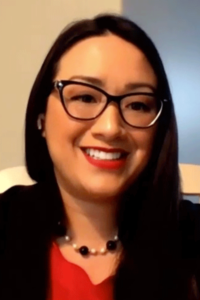
Half a billion people worldwide use digital devices for health-related purposes, from managing chronic diseases to tracking diet and physical activity. In addition, 81% of U.S. adults own a smartphone.
Certified diabetes care and education specialist Rachel Stahl, MS, RD, CDN, said these numbers demonstrate the important role that personal digital devices and apps play in diabetes management.
Stahl joined three other health innovation experts in the virtual symposium Taking the Technology Plunge—Integrating Digital Technology into Practice during this year’s Scientific Sessions. The presentation can be viewed by registered meeting attendees at ADA2020.org through September 10, 2020. If you haven’t registered for the Virtual 80th Scientific Sessions, register today to access all of the valuable meeting content.
Stahl, a registered dietitian at New York-Presbyterian Hospital and Weill Cornell Medicine, provided an overview of diabetes apps and discussed the clinical implications of recommending apps to patients. Apps exist at every stage along the modern patient’s journey, she noted, from awareness of symptoms to seeking medical help, treatment, monitoring, lifestyle change, and ongoing care.

When evaluating diabetes apps, Stahl said providers need to consider the patient experience, potential clinical benefits, and how app data affects provider workflow. Other considerations include safety, privacy, cost, data collection, analytics, and decision support.
“Some diabetes apps wirelessly transfer data from Bluetooth-enabled glucose meters or CGMs (continuous glucose monitors), ensuring precise timestamps and data,” Stahl said. “This makes things so much easier on a patient. It takes the effort off the patient and organizes the data in a highly readable way. This also gives important insights and easily shares reports with providers. From a clinician perspective, this eliminates concerns about the accuracy of data entry, illegible handwriting, or patients forgetting their logbooks.”
David Ahn, MD, Program Director of Hoag’s Mary & Dick Allen Diabetes Center, discussed the ever-increasing amount of personal health data collected by patient devices.
“There’s a long list of things you can pretty easily capture from someone’s smartphone, watch, or Fitbit,” he said. “In addition, we’re seeing smart insulin pens that send data to smartphone apps. So how do we handle all this data?”
Actually, Dr. Ahn said it would be better to ask how to improve the data: How do we visualize the data? How can we make the data actionable? How do we archive and share data?
“Smartphones are fantastic because they serve as a hub for diabetes data,” he said. “If done well, the smartphone can consolidate all the information. And not only does it consolidate information on the patient’s phone, it’s able to send that data to the provider. The beauty with all this data is that if you can present it in an actionable way and consolidate the different data points on one screen, it really helps the quality of the patient-provider interaction.”

David V. Wagner, PhD, Research Director of the Novel Interventions in Children’s Healthcare (NICH) Program and Assistant Professor of Pediatrics at Oregon Health & Science University, discussed several ways text messages are being leveraged to improve diabetes care. He shared data from the NICH intervention program that illustrate how texting youth patients can help them meet self-management goals.
“Why text?” Dr. Wagner asked. “Everyone does it. It’s the one form of telecommunication that seems to transcend socioeconomic status and race—offering the potential to help deal with disparities. Our evidence shows high satisfaction with texting. Texting also offers us an opportunity to provide feedback and demonstrate consequences quickly after behaviors.”
Dr. Wagner reported that 83% of participants in the NICH model, which includes frequent use of texting, experienced a recent hospital admission for diabetic ketoacidosis before entering the program. By comparison, 42% of participants were hospitalized for diabetic ketoacidosis after entering the program.
“Those in the program were much less likely to experience an acute event,” said Dr. Wagner, adding that the data also indicated an association between text messaging and A1C.
“We saw associations between reduced A1C and overall texts, positive texts, and texts sent after business hours,” he said. “The more texts an individual received that were perceived to be positive, the greater reduction in A1C they tended to have. We also saw that more frequent texts to patients were associated with fewer days admitted to hospital, and with lower health care costs. We also saw that the more often emojis were included in text messages, the greater the improvements we saw.”

Michelle Litchman, PhD, FNP-BC, Assistant Professor at the University of Utah College of Nursing, explored the intersection of diabetes technology and peer support.
“When we think about diabetes technology, we often think about devices or an app or telehealth,” she said. “But I want to consider the idea of online technology as being diabetes technology.”
Dr. Litchman shared results from a review of online and offline peer-support interventions, and specifically how participation in online diabetes peer support affected a patient’s A1C.
“The effects were either positive or neutral,” she said. “The more we saw people engaging, the better the likelihood that their A1C would be less than 7%. Importantly, there’s been no A1C increases reported in the literature associated with online peer support.”
[gap]
VIEW THIS PRESENTATION
Already registered?
View this presentation at ADA2020.org
Not yet registered?
Register now to access all presentations from the Virtual 80th Scientific Sessions